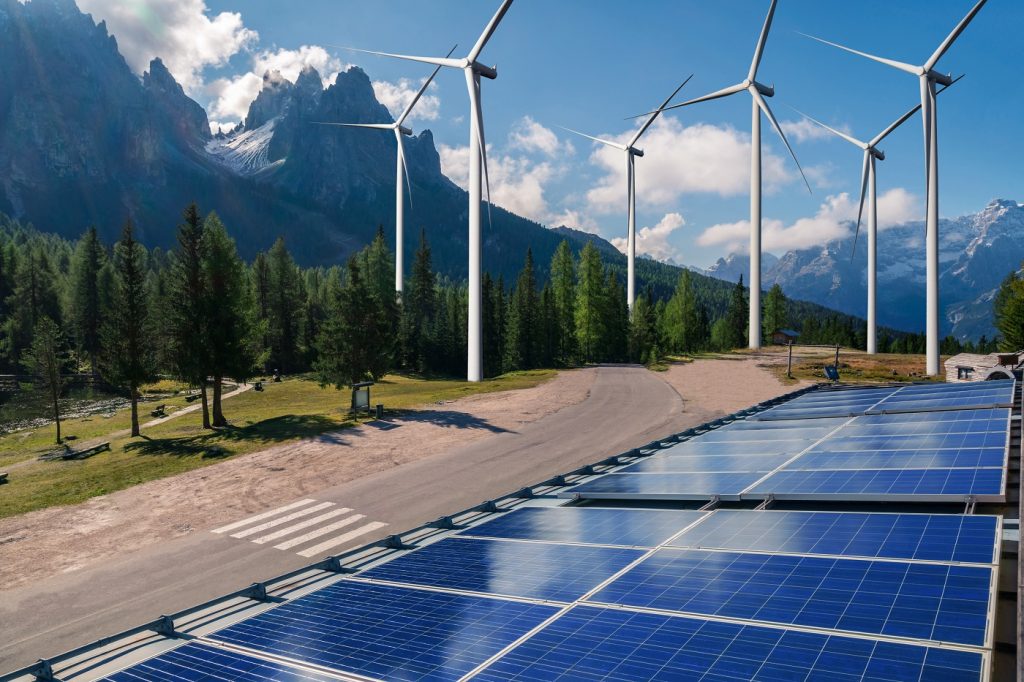Renewable energy is energy obtained from naturally renewable sources such as solar energy, wind energy, hydraulic energy (water, rain, tide, wave), geothermal energy, biomass energy. It is a type of energy that can be continuously reinforced by nature and power obtained from the resources in nature.
Renewable energy, which is expected to replace conventional fuels in the future, provides convenience in areas such as electricity generation, heating and cooling, transportation, and energy services in off-grid rural areas.
In recorded history, the primary sources of traditional renewable energy were human labor, animal power, rain, hydropower, wind, plant and animal waste. Today, with the systems and resources relied on same basis, with the support of technological developments, renewable clean energy is becoming a type of energy that looks to the future more hopefully, low costed and / but can be obtained and stored faster.
Before the development of coal in the mid-19th century, almost all of the energy used was renewable. The earliest known use of renewable energy in the form of traditional biomass developed for firing goes back more than a million years. Probably the second oldest use of renewable energy is the use of wind power to float ships on water. This practice dates back to about 7000 years ago, to ships in the Persian Gulf and the Nile.
There is strong support in international opinion polls for promoting renewable resources such as solar power and wind power. The rapid spread of renewable energy and energy efficiency technologies surely provide significant energy security, climate change mitigation and economic benefits.
Renewable Energy Technologies
Renewable energy sources are found in wide geographical areas, unlike fossil fuels concentrated in a limited number of countries. Renewable technologies are suitable for rural, remote areas and developing countries where energy is often important to human development. Since most renewable energy technologies provide electricity, they are applied in conjunction with advanced electrification, such as the conversion of electricity to heat, highly efficient mechanical energy. Electrification with renewable energy is more efficient and therefore provides significant savings in primary energy requirements.
The rapid spread of renewable energy and energy efficiency and the technological diversity of energy sources will provide significant energy security and economic benefits. In addition, it will reduce environmental pollution such as air pollution caused by the burning of fossil fuels and contribute to the improvement of public health. Renewable energy sources such as solar, hydro and wind, from which energy is obtained directly or indirectly, are expected to serve humanity for almost 1 billion more years. However, predicting the global warming due to Sun in this process means that the Earth’s surface becomes too hot for a water to exist.
By the help of falling costs of some renewable energy equipment such as wind turbines and solar panels, climate change and global warming concerns are driving renewable energy use to increase. According to sources, in order to reduce the rise in average global temperatures by 2.0 ° C (3.6 ° F), the total share of renewable energy in the energy mix (including power, heat and transport) needs to grow six times faster.
Solar energy
Solar energy is heat and bright light whose source is the Sun. Planar solar collectors are used in photovoltaic (PV), concentrated solar energy (CSP), solar architecture, artificial photosynthesis technologies.
By the end of 2015, 1.2% of the electricity produced in the world was produced by PV panels; Its share in renewable energy is 5%.
Wind power
The kinetic energy carried by the wind has been used in windmills and sailing ships for thousands of years. Thanks to wind turbines, electricity is obtained from this energy.
By the end of 2015, 3.7% of the electricity produced in the world was produced by wind power; Its share in renewable energy is 15.6%.
Geothermal energy
Geothermal energy refers to the underground waters heated by the internal heat of the earth, spreading to the earth from the hot zone in the heat center. Geothermal Energy is used in heating and electricity generation.
Hydraulic energy
Hydraulic power or water power is the power obtained from the energy of falling or fast flowing water. Since ancient times, hydraulic power has been used as a renewable energy source in many types of water mills, irrigation and different types of mechanical devices; It has been used to drive wheat mills, sawmills, weaving mills, harbor cranes, ore crushers, large powerful hammers, elevators, industrial rollers and drums. Pumps operating with falling water to generate compressed air were sometimes used to power other mechanisms from a distance. Today, a significant part of the electricity produced in the world is produced in hydroelectric power plants.
As of the end of 2015, 16.6% of the electricity produced in the world was produced by hydraulic power; Its share in renewable energy is 70%.
Sea Energy, also called ocean energy, refers to the energy carried by ocean waves, tides, salinity and ocean temperature differences. The movement of water in the world’s oceans creates a huge storehouse of kinetic energy, or energy in motion. This energy can be used to generate electricity.
Biomass energy
It is a type of energy produced by animal and plant wastes that are stayed in nature. Energy is produced out of the feces of farm animals, and dead trees, etc. Also Biogas is produced from animal wastes and biodiesel is from plants.
Cellulosic biomass derived from non-food sources such as trees and grasses is being developed as a raw material for ethanol production. Although ethanol can also be used in its pure form as fuel for vehicles, it is mostly used as a gasoline additive to increase octane and improve vehicle emissions.
Biodiesel can be used as fuel for vehicles in its pure form, but is often used as a diesel additive to reduce particulate, carbon monoxide and hydrocarbon levels from diesel engine vehicles.
Market and industry trends
In the US, renewable energy has been more effective at creating jobs than coal or oil. In 2016, employment in the US sector increased by 6 percent, causing employment in the non-renewable energy sector to decrease by 18 percent. Worldwide, renewable energy sources provide around 8.1 million jobs as of 2016.
Globally associated with renewable energy industries in 2017, there are 7.7 million employees, according to an estimate, and solar photovoltaics are in a position to be the largest renewable employer.
Unlike fossil fuels, renewable fuels can be produced in any country and create a strategic advantage.
The International Renewable Energy Agency (IRENA) is an intergovernmental organization promoting the adoption of renewable energy worldwide. It aims to provide concrete policy advice and facilitate capacity building and technology transfer. IRENA was founded in 2009 by 75 countries that have signed IRENA’s charter. As of April 2019, IRENA has 160 member countries.
The 2015 Paris Agreement on climate change has motivated many countries to develop or improve renewable energy policies. In 2017, a total of 121 countries adopted some form of renewable energy policy.
Global goal
According to the data, as of the end of 2015, approximately 23.7% of the electricity produced in the world was produced using renewable energy sources. According to the projections, electricity production from renewable energy, which was 5288 TWh (terawatt.hour) in 2014, will be over 10000 TWh by the 2040s. In 2017, renewable energy sources contributed 19.3% to people’s global energy consumption and 24.5% to electricity generation. This energy consumption is 8.9% from traditional biomass, 4.2% from heat energy (modern biomass, geothermal and solar heat), 3.9% from hydroelectric, and the remaining 2.2% from electricity in terms of wind, solar, geothermal and other biomass. Renewable energy systems are rapidly becoming more efficient and cheaper, and their share in total energy consumption is increasing. As of 2019, more than two-thirds of the newly installed electricity capacity worldwide is renewable energy. The increase in coal and oil consumption could end by 2020 due to increased intake of renewable energy and natural gas.
At the national respect, at least 30 countries in the world currently provide more than 20 percent of their energy supply from renewable energy. It is estimated that national renewable energy markets will continue to grow strongly over the next decade and beyond. Some locations and at least two countries, Iceland and Norway, already produce all their electricity using renewable energy, and many other countries have set goals to achieve 100% renewable energy in the future. At least 47 countries around the world currently own more than 50 percent of electricity from renewable sources.
By 2040, renewable energy is projected to equal coal and natural gas electricity generation. Various jurisdictions, including Denmark, Germany, the stateof South Australia and some US states, have achieved high integration of variable renewable energy sources. For example, in 2015 wind power met 42% of electricity demand in Denmark, 23.2% in Portugal and 15.5% in Uruguay.
Obstacles to the widespread implementation of large-scale renewable and low-carbon energy strategies are political, not technological. According to the 2013 Post Carbon Pathways report, which reviews many international studies, key obstacles are: denial of climate change, the fossil fuel lobby, political inactivity, unsustainable energy consumption, outdated energy infrastructure, and financial constraints.
Emerging Technologies
Other renewable energy technologies are still in development and include cellulosic ethanol, hot dry rock geothermal energy and marine energy. These technologies are not yet widely seen or have limited commercialization. Many of them are on the horizon and may have comparable potential to other renewable energy technologies, but still haven’t received enough attention.
Geopolitics of renewable energy
Since 2010, discussions have increased about the geopolitical implications of increasing renewable energy use. It is claimed that the position of former fossil fuel exporters in international relations will weaken and countries with abundant renewable energy sources will strengthen. In addition, countries rich in critical materials for renewable energy technologies is expected to increase in importance in international relations.
Old fossil fuel exporters are expected to lose power, while the positions of former fossil fuel importers and countries rich in renewable energy resources are expected to strengthen.
Conclusion
Renewable electricity generation from sources such as wind power and solar power is variable, that causes in a decrease in the capacity factor.
Since the power density of renewable energy sources per land area is at best three times smaller than fossil or nuclear energy, renewable power plants tend to occupy thousands of hectares, causing environmental concerns and opposition from local residents, especially in densely populated countries. While solar power plants compete with arable land and nature reserves, onshore wind farms face opposition due to aesthetic concerns and noise affecting both humans and wildlife.
There are claims that renewable energy facilities built threaten the habitats of plant and animal species around the world. The important thing is to ensure that renewable energy facilities are installed in places where they will not harm biodiversity.
Biomass and biofuels emit a large amount of air pollution when burned in terms of emissions and contrary to the ability to contribute to CO reduction. Moreover, biomass and biofuels consume large amounts of water. Other renewable sources such as wind power, photovoltaic and hydroelectricity have the advantage of saving water, reducing pollution and reducing emissions, CO.
The production of photovoltaic panels, wind turbines and batteries requires significant amounts of rare earth elements and increases mining activities with significant social and environmental impact. Due to the co-occurrence of rare earth and radioactive elements (thorium, uranium and radium), rare earth mining results in the production of low level radioactive waste.
Projects, mostly have good chances of success if they have broad public support and the consent of local communities. This means giving communities both a voice and a share. In countries such as Germany and Denmark, many renewable projects are owned by communities, particularly through cooperative structures, and contribute significantly to renewable energy distribution.
The renewable energy technologies market continues to grow. High oil prices, oil wars, oil spills, the promotion of electric vehicles and renewable electricity, nuclear disasters, increasing climate change concerns about the future of all living things, and along with them, increasing official supports, incentives, facilities in renewable energy legislation guide the trade in this regard.
Despite the ever-increasing contribution and success of renewable energy to electrical energy, countries dominated by fossil fuels have no plans to derive this power from renewable sources. Only Scotland and Ontario stopped burning coal due to their high natural gas supply. In the field of transport, fossil fuels are more ingrained and more difficult to find a solution. Twenty years after the Kyoto Protocol, fossil fuels are still our primary energy source unfortunately and consumption continues to increase.
The International Energy Agency noted that the diffusion of renewable technologies often increases the diversity of electricity sources and contributes to the system’s flexibility and resistance to central shocks through local generation.




